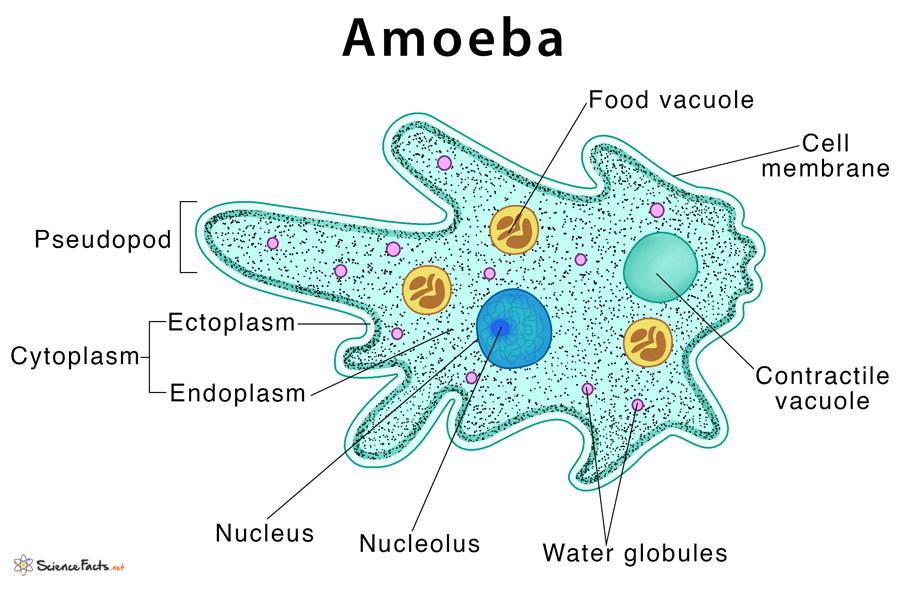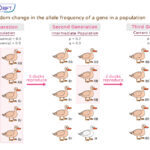Amoeba: Parts and Structure with Characteristics and Diagram
What is Amoeba
Amoeba is an aquatic, single-cell (unicellular) organism with membrane-bound (eukaryotic) organelles that has no definite shape. It is capable of movement. When seen under a microscope, the cell looks like a tiny blob of colorless jelly with a dark speck inside it. Some parasitic amoebae living inside animal bodies, including humans, can cause various intestinal disorders such as diarrhea, ulcers, and liver abscesses. Entamoeba histolytica is an example of such amoeba that causes a disease called amoebic dysentery or amebiasis in humans.
The term ‘amoeba’ is derived from the Greek word ‘amoibe’ meaning ‘change’. German naturalist August Johann Rösel von Rosenhof discovered and described amoeba in 1755.
Scientific Classification
| Domain | Eukarya |
| Kingdom | Protista |
| Phyllum | Protozoa |
| Class | Rhizopoda |
| Order | Amoebida |
| Family | Amoebidae |
Where Do They Live
They are found in salt and freshwater bodiessuch as ponds, lakes, and slow-moving rivers and wet soils, the natural habitat of amoeba. Some parasitic amoebae are also found inside animal bodies, including humans.
Characteristics
How Do Amoeba Move
They move by changing their shape, using temporary cytoplasmic extensions called pseudopodia, or false feet. The unique pattern has been named as amoeboid movement after the organism.
How Do They Eat
They catch food such as algae, bacteria, plant cells, microscopic protozoa, and metazoans through absorption using pseudopodia, a process termed phagocytosis. This mode of nutrition in amoeba is called holozoic nutrition where the food particles are engulfed to form a vacuole around it.
Other Important Features:
- Takes in oxygen and gives out carbon dioxide across the cell membrane through diffusion, which helps to produce energy in the form of ATP
- Exchanges water, ions and other small molecules across its cell membrane using the process of osmosis
- Has an average life span of 2 days
- Under unfavorable growing conditions, it transforms into a protective ball called the microbial cyst
Structure
It appears as an irregular, jelly-like tiny mass of hyaline protoplasm. Amoeba has no fixed shape, and the outline of the body continues to change due to the formation of small finger-like cytoplasmic outgrowths called pseudopodia.
How Big Can it Get
It varies widely in size and shape from being extremely small between 2.3 – 3.0 µm to exceptionally large such as 20 cm in diameter. The so-called ‘giant amoebae’, Pelomyxa palustris and Chaos carolinense, can be as large as 5 mm.
Its Parts
1. Cell membrane: Also called plasmalemma, it is a thin-layered membrane composed of protein and lipid molecules that restricts the entry and exit of substances in and out of the cell.
2. Cytoplasm: A mass of a jelly-like substance that holds all the other organelles. It consists of two parts:
a) Ectoplasm: The outer gelatinous, semi-solid layer called plasmagel, found just beneath the cell membrane.
b) Endoplasm: The less viscous fluid called plasmasol that surrounds the ectoplasm.
3. Nucleus: Small region within the cytoplasm that contains the genetic material or DNA in the form of chromatin granules along with the nucleoplasm, held within the nuclear membrane.
4. Pseudopod: Also called false feet, it is a temporary arm-like cytoplasmic extension that helps amoeba to perform locomotion and capture food. There can be multiple pseudopods in a cell, together known as pseudopodia.
5. Contractile vacuole: A clear transparent body filled with a watery fluid, found in the outer part of the endoplasm. The food captured using pseudopodia are digested, and the wastes are expelled using contractile vacuoles. It also helps to maintain proper water and salt concentrations within the organism.
6. Food vacuole: Different-sized vacuoles that help in the digestion of food. There are multiple food vacuoles unevenly scattered in the cytoplasm.
7. Water globules: Several small, spherical, colorless, and non-contractile vacuoles filled with water that helps to store water and essential minerals.
How do Amoeba Reproduce
Amoeba reproduces asexually in the following methods:
Binary Fission: The most common mode of reproduction in amoeba, where the parent cell divides equally to distribute its content into two daughter cells. This is the reason why amoeba is called immortal, as the parent cell itself lives on in the daughter cells, which will then give rise to more amoeba cells.
Multiple Fission: Occurs under unfavorable conditions where the parent cell undergoes multiple divisions to form 500- 600 daughter cells.
Sporulation: It is the inactive phase of reproduction during which the nucleus of amoeba undergoes multiple divisions to form numerous spores. Under favorable conditions of growth, the spores germinate back into reproductive cells. This is an important form of adaptation in amoeba.
Regeneration: A part of the amoeba’s body having a fragment of its nucleus develops into a completely new organism.
FAQs
Ans. Amoeba changes its shape using pseudopodia that help in their movement.
Ans. Amoeba does not have a cell wall but has a cell membrane that forms the outer layer of the organism.
Ans. An amoeba is animal-like due to certain features such as an absence of cell wall, its inability to produce food, and its capacity to move from one place to another.
Ans. Amoeba is heterotrophic because it obtains food from other organisms.
Ans. Its food vacuoles are formed when the food is pushed inside the cell, causing the membrane to bend inward. As the food pushes against the membrane, it stretches inward until the food particles are completely inside the cell, when the membrane pinches off, forming a vacuole.
Ans. Naegleria fowleri popularly known as ‘brain-eating amoeba’ is a species of the genus Naegleria, belonging to the phylum Percolozoa, which is technically not classified as a true amoeba. It is a free-living, bacteria-eating microorganism that can be pathogenic, causing an extremely rare fulminant and fatal brain infection called naegleriasis, also known as primary amoebic meningoencephalitis. They are commonly found in warm freshwaters such as lakes, rivers, and hot springs, and also in wet soil.
-
References
Article was last reviewed on Thursday, October 29, 2020






